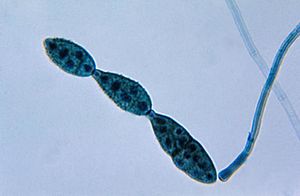Spore facts for kids
Spores are tiny, special cells that help many living things reproduce or survive tough times. Think of them like tiny seeds, but simpler! Fungi (like mushrooms), mosses, and ferns use spores to make new plants. Some bacteria and tiny creatures called protozoa also make spores to survive for a very long time.
For plants that make seeds, spores are single cells that grow into parts that help make a seed. Seeds are more complex than spores because they have food stored inside to help the new plant grow, which spores don't have.
Contents
Fungi and Their Spores
Fungi, like the mushrooms you see, make spores to reproduce. Some spores are made without needing another fungus, which is called asexual reproduction. Others need two fungi to combine, which is sexual reproduction.
Conidia are a type of asexual spore made by fungi. They are not able to move on their own. These spores are made through a cell process called mitosis, which creates exact copies of the parent fungus. Conidia are very small and can spread easily, helping the fungus grow in new places if the conditions are right.
Many fungi, especially a group called Ascomycetes, make conidia on special stalks called conidiophores. The shape of these stalks can be very unique for different types of fungi, helping scientists figure out what kind of fungus they are looking at.
- When a spore lands in a good spot, it can start to grow. This is called Germination.
- Some spores are made inside special cases called sporangia.
Super Tough Bacterial Spores
Bacterial spores are incredibly strong and can survive in very harsh conditions. For example, the bacteria that cause tetanus and anthrax can form spores that live in the soil for many, many years.
Scientists first learned about these tough spores in the 1800s. A biologist saw tiny, bright, round shapes inside bacterial cells under a microscope. Even when he boiled the bacteria for five minutes (which killed the bacteria), these little shapes survived! When conditions became good again, these spores would "wake up" and grow into new bacteria.
How Plants Use Spores
Plants have a special way of growing that involves two main stages, like two different generations. One stage is called the sporophyte, which makes spores. These spores are made through a process called meiosis. The other stage is called the gametophyte, which makes special cells called gametes that combine to form a new plant. So, spores are a key part of how many plants, especially ferns and mosses, start their new life.
Images for kids
-
Fresh snow on rough-stalked feather-moss. You can see the sporophytes (which make spores) before they release their spores.
-
Fossil trilete spores (blue) and a spore tetrad (green) from the Silurian period (a very long time ago!).
-
Tricolpate pollen of Ricinus. Pollen grains are like tiny packages that carry the male part of a plant.
-
Spores of the moss Bartramia ithyphylla, seen under a microscope (400x magnification).
-
Spores and elaters (structures that help spread spores) from a horsetail plant. (Equisetum, microscopic view)
See also
 In Spanish: Espora para niños
In Spanish: Espora para niños












